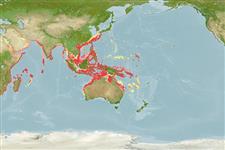Environment: milieu / climate zone / intervalo de profundidade / distribution range
Ecologia
marinhas; estuarina associadas(os) a recifes; intervalo de profundidade 50 - 200 m (Ref. 47690). Subtropical; 32°N - 30°S, 30°E - 169°E
Indo-West Pacific: East Africa, as far south as Durban in South Africa, to southern Japan and northeastern Australia, east to New Caledonia.
Length at first maturity / Tamanho / Peso / Idade
Maturidade: Lm 14.0 range ? - ? cm
Max length : 30.0 cm TL macho/indeterminado; (Ref. 47690); common length : 20.0 cm TL macho/indeterminado; (Ref. 47690)
Descrição breve
Chaves de identificação | Morfologia | Morfometria
Espinhos dorsais (total) : 3 - 4; Raios dorsais moles (total) : 40 - 45; Espinhos anais: 0; Raios anais moles: 30 - 33. This species is distinguished by its very deep body, almost triangular, extremely compressed; sharp-edged breast; greatest body depth below lateral line at least 4 times greater than greatest body depth above lateral line; anal fin very long-based, commencing at point of insertion of pelvic fins, uniformly very low; dorsal spines (X in juveniles) reducing in number with increasing age. Colour of body with upper sides deep metallic blue, the rest silvery, a row of round to ovoid, dark slaty-blue spots above and below lateral line, sometimes a few additional spots above and below these rows; pelvic fins with a trace of blue, other fins hyaline or slightly dusky (Ref. 47690).
Body shape (shape guide): short and / or deep; Cross section: compressed.
Inhabits deeper coastal waters near the bottom on both the continental shelves and around major island groups; sometimes in river estuaries (Ref. 47690, 48635). Found in schools (Ref. 47690, 48635). Feeds on benthic invertebrates (Ref. 5213). Readily dries in air without salting (Ref. 4375, 48635). Caught in trawls and by beach seine, but mainly by trawling, often incidentally. Marketed fresh and dried (Ref. 47690). Minimum depth from Ref. 30573.
Life cycle and mating behavior
Maturidade | Reprodução | Desova | Ovos | Fecundidade | Larvas
Heemstra, P.C., 1984. Menidae. In W. Fischer and G. Bianchi (eds.) FAO species identification sheets for fishery purposes. Western Indian Ocean fishing area 51. Vol. 3. (Ref. 3465)
Categoria na Lista Vermelha da IUCN (Ref. 130435: Version 2025-1)
Ameaça para o homem
Harmless
Utilização humana
Pescarias: espécies comerciais
Ferramentas
Relatórios especiais
Descarregue XML
Fontes da internet
Estimates based on models
Preferred temperature (Ref.
123201): 19.8 - 27.6, mean 24.4 °C (based on 503 cells).
Phylogenetic diversity index (Ref.
82804): PD
50 = 1.5000 [Uniqueness, from 0.5 = low to 2.0 = high].
Bayesian length-weight: a=0.02089 (0.00836 - 0.05223), b=3.03 (2.81 - 3.25), in cm total length, based on LWR estimates for this (Sub)family-body shape (Ref.
93245).
Nível Trófico (Ref.
69278): 3.5 ±0.41 se; based on food items.
Resiliência (Ref.
120179): Elevada, tempo mínimo de duplicação da população menor que 15 meses (K=0.19-1.2).
Fishing Vulnerability (Ref.
59153): Low vulnerability (17 of 100).
🛈
Climate Vulnerability (Ref.
125649): Low to moderate vulnerability (33 of 100).
🛈
Nutrients (Ref.
124155): Calcium = 27.4 [11.6, 61.0] mg/100g; Iron = 0.484 [0.271, 0.908] mg/100g; Protein = 19.4 [18.2, 20.6] %; Omega3 = 0.205 [0.114, 0.368] g/100g; Selenium = 17.5 [7.8, 37.5] μg/100g; VitaminA = 43.9 [10.1, 182.5] μg/100g; Zinc = 0.868 [0.548, 1.324] mg/100g (wet weight);
